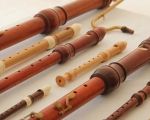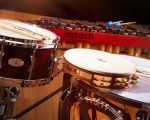What Are the Different Types of Musical Instruments?
As a musician, I’ve always been fascinated by the wide variety of musical instruments available. Each one brings its own unique sound and personality to the music. Whether you're a seasoned performer or just starting out, understanding the different types of musical instruments is essential. In this article, we’ll dive into the major categories of musical instruments, exploring how they are classified and how they contribute to various styles of music. So, if you’re wondering what makes a piano different from a guitar or why brass instruments are so distinct, this guide will help you gain a deeper understanding of the musical world.
1. The Four Main Categories of Musical Instruments
Musical instruments can generally be divided into four broad categories: string instruments, wind instruments, percussion instruments, and keyboard instruments. These categories help classify instruments based on how they produce sound. Let’s explore each category in more detail:
1.1 String Instruments
String instruments are those that produce sound by vibrating strings. The sound is typically created by plucking, bowing, or striking the strings. The most common string instruments are the violin, guitar, cello, and harp. As a guitar player, I can tell you that the quality of sound varies greatly depending on the instrument's construction, the material of the strings, and the technique used to play it.
String instruments are versatile and are used across a wide range of genres, from classical orchestras to contemporary rock bands. The resonance of a string instrument can evoke powerful emotions, which is why they’re favored by many musicians. If you’re just starting out, a simple acoustic guitar might be your gateway into this world, while more advanced musicians might choose a grand piano or an electric violin for more nuanced performances.
1.2 Wind Instruments
Wind instruments produce sound when air is blown through them. These instruments can be further divided into two types: brass and woodwind. Brass instruments, such as trumpets, trombones, and tubas, are made from metal and create sound through the vibration of the player’s lips. Woodwind instruments, like flutes, clarinets, and saxophones, are typically made from wood or metal and produce sound when air is passed through a reed or a hole in the instrument.
One of the most fascinating aspects of wind instruments is the range of sounds they can produce, depending on the skill of the musician. For example, the trumpet’s bold sound contrasts sharply with the smooth, mellow tones of the flute. As a musician, I’ve always admired the versatility of wind instruments, especially in ensembles where the brass section and woodwind section can complement each other beautifully.
1.3 Percussion Instruments
Percussion instruments are a group of instruments that produce sound by being struck, shaken, or scraped. These instruments include drums, tambourines, cymbals, maracas, and xylophones. In a traditional drum kit, for instance, the bass drum, snare, and cymbals are all percussion instruments, each adding a distinctive layer of rhythm to a performance.
Percussion is the backbone of most music, providing the rhythm that drives the melody forward. I’ve personally played the drums in a band, and I can attest to the fact that percussion instruments can bring an entire musical piece to life. Whether it’s the thunderous boom of a bass drum or the bright ting of a cymbal, percussion instruments add dynamic energy to any genre of music, from rock to jazz to classical.
1.4 Keyboard Instruments
Keyboard instruments are a fascinating category because they combine elements of string, wind, and percussion instruments. The piano, organ, and synthesizer are all examples of keyboard instruments. These instruments have a series of keys that, when pressed, create a sound through different mechanisms. For instance, on a piano, pressing a key causes a hammer to strike the strings, while on a synthesizer, the sound is electronically generated.
Keyboard instruments are incredibly versatile and can be used to create a wide range of sounds. As a piano player, I can tell you that the sheer range of notes and dynamics available on a keyboard is one of the reasons why it's such a popular choice among musicians. From the gentle resonance of a grand piano to the futuristic sounds of a synthesizer, keyboard instruments can adapt to virtually any musical genre.
2. How Musical Instruments Are Classified
While we’ve discussed the four main categories of musical instruments, there are also more specific classifications based on the instrument's design, usage, and sound production. Instruments can be classified by:
2.1 Family and Range
Instruments are often grouped into families based on their shared characteristics. For example, within the string family, we have violins, violas, cellos, and basses. Each instrument in the family plays a different role and has a unique range of notes it can produce. Similarly, wind instruments are grouped into brass and woodwinds, each with its own set of characteristics that distinguish them from one another.
2.2 Tone and Technique
Another way to classify instruments is by their tone quality (timbre) and the technique required to play them. For example, string instruments are typically played with a bow or plucked with fingers, while wind instruments require breath control. Some instruments, like the saxophone, require a combination of both breath and finger control to produce sound.
2.3 Role in Performance
In ensembles or orchestras, instruments are often classified based on the role they play in the composition. For instance, percussion instruments may provide the rhythm, while string instruments often carry the melody. The keyboard, depending on the piece, can serve both roles. These roles help determine where instruments fit in an arrangement and how they work together in harmony.
3. Choosing the Right Instrument for You
If you’re just starting your musical journey or are considering learning a new instrument, the options can be overwhelming. It’s important to think about several factors when choosing the right musical instrument:
3.1 Consider Your Musical Interests
First, think about the kind of music you enjoy listening to. If you love classical music, a string instrument like the violin or cello might be your best choice. If you’re into rock or jazz, a guitar or saxophone could be more suited to your style. Personally, I’ve always been drawn to instruments that provide a range of expression, such as the piano, because it offers both melody and harmony.
3.2 Evaluate Your Physical Ability
Some instruments require more physical strength and dexterity than others. Drums and brass instruments can be quite physically demanding, while keyboard and string instruments may require fine motor skills and finger strength. I’ve seen beginners struggle with instruments that require intricate finger movements, so it’s important to consider your comfort level with the physical demands of each instrument.
3.3 Think About Availability and Cost
Lastly, consider the availability of the instrument you want to learn and its cost. While some instruments like the guitar and keyboard are relatively inexpensive and easy to find, others like the double bass or grand piano may require more investment in both time and money. I’ve found that entry-level instruments are a great way to begin, and once you develop your skills, you can upgrade to more advanced models.
4. Conclusion
Whether you're a beginner or an experienced musician, understanding the different types of musical instruments is essential to finding the right one for you. From the string and wind instruments to the percussion and keyboard categories, each instrument has its own unique sound and contribution to music. If you’re passionate about music and eager to dive deeper into the world of musical instruments, there are endless options available to suit your interests and skills. Take your time exploring different instruments, and you’ll find the one that resonates with you the most. Happy playing!








